My earliest memories of sailing date back to the 1950s when I was growing up in Edmonds, Washington, a small town on the shores of Puget Sound. I was in first or second grade then, too young to appreciate the boat that my father brought home. He had seen it languishing alongside a barn somewhere in one of the rural areas outside of Edmonds, bought it, and went to work putting it back in usable condition.
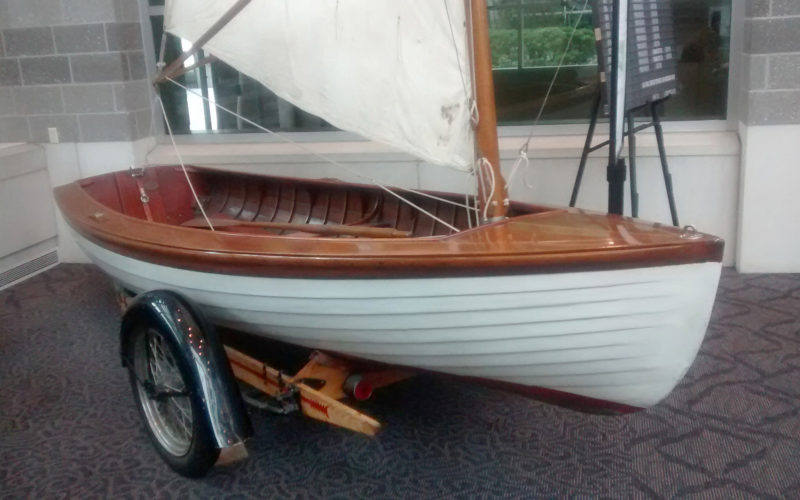 Christopher Cunningham
Christopher CunninghamThe Amphi-craft, christened PRIM, belongs to the Herreshoff Marine Museum in Bristol, Rhode Island, and is on display at the T.F. Green Airport in Providence. It was built about the same time as my father’s boat and has many of the features I remember.
 Evelyn Ansel / Herreshoff Marine Museum
Evelyn Ansel / Herreshoff Marine MuseumThe builder’s plate is stamped with Herreshoff’s number identifying the boat. PRIM bears #1276, recorded in the company records as the first Amphi-craft built. The dents in the wood at the top of the transom indicate the boat had been used with an outboard, as it was designed to be.
The boat was a Herreshoff Amphi-craft, designed in 1935 by Sidney Herreshoff, Captain Nat’s eldest son. Dad had always been enamored of wooden boats. He grew up in Lowell, Massachusetts, and summered in Marblehead where he frequently sailed, MOLLY MAY, his father’s cutter and drove the harbor launch taking yachtsmen to and from their boats at anchor. He had also visited L. Francis Herreshoff, Sidney’s brother, in the Herreshoff Castle on the hill above the harbor. To find a Herreshoff dinghy on the West Coast must have seemed like kismet to Dad, and although he was supporting a family of five on a teacher’s salary, I think he would have paid anything to have it.
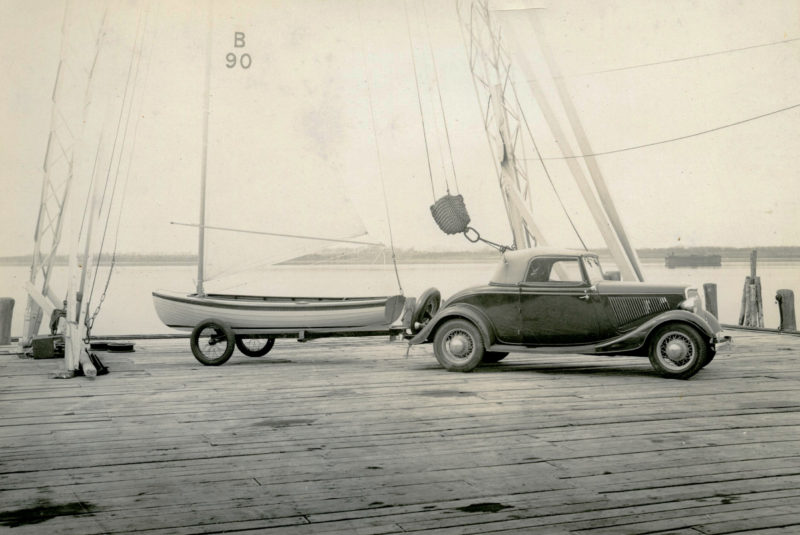 courtesy of the Herreshoff Marine Museum / America's Cup Hall of Fame
courtesy of the Herreshoff Marine Museum / America's Cup Hall of Fame This Amphi-craft here isn’t riding on the trailer designed for it. The car towing it appears to be a 1934 Ford Cabriolet Convertible Coupe, Roadster.
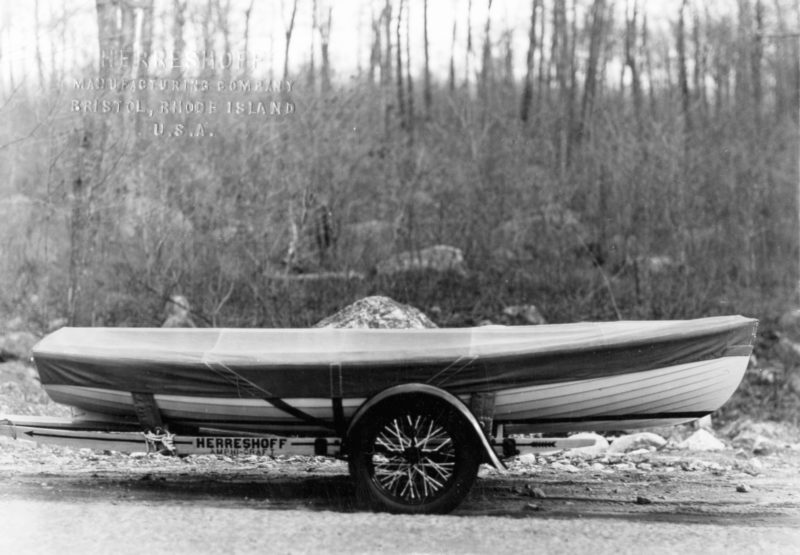 Courtesy of the Herreshoff Marine Museum / America's Cup Hall of Fame
Courtesy of the Herreshoff Marine Museum / America's Cup Hall of Fame Most of the Amphi-craft built were delivered with a custom trailer and canvas cover at a cost of $560. An outboard added $55 to the pricetag.
Only 17 of the 13′ lapstrake dinghies were ever built, according to a registry of Herreshoff vessels, and two of them were shipped to Everett, Washington, a half-hour drive from Edmonds. So the Herreshoff number of Dad’s boat must have been either #1305, sold to O.C. Schwenck, or #1306, sold to Stearns Marine.
The boat still had the trailer that had been built for it by the Herreshoff shop. It had an oak frame and was equipped with spoked wheels and ducktail fenders built by the Indian Motorcycle company. The boat sat on the trailer with the stern on the hitch end of the trailer and the bow at the tail end. Dad thought that launching and recovery with the bow facing the chop was a lot easier than with the transom getting slapped by the waves.
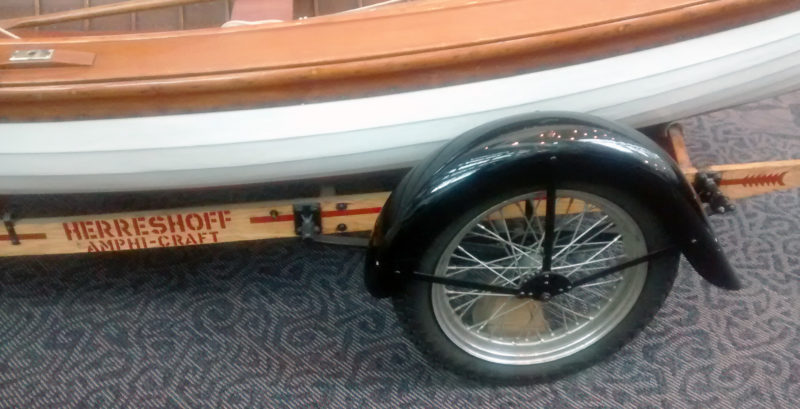 Christopher Cunningham
Christopher CunninghamThe wheels and fenders provided by the Indian Motorcycle company gave the trailer a classy look.
The sheerstrakes were as much decorative molding as they were planking. Where you would expect to find a half-round sheer guard nailed to the sheer plank, that shape was carved into the mahogany plank, flowing in a smooth continuous curve from top to bottom. The mast was in two parts and stowed aboard the boat for trailering. Between the upper and lower halves was a scarf joint that had two stainless-steel bands that kept the blunt ends where they belonged.
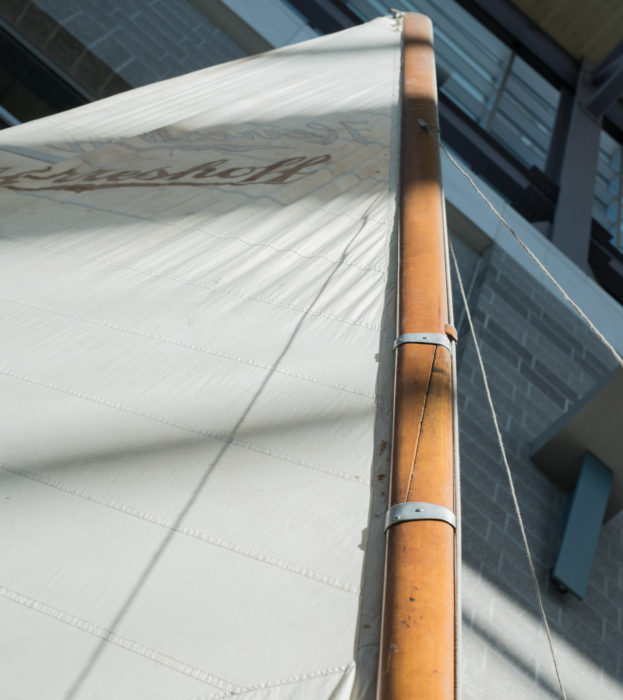 Evelyn Ansel / Herreshoff Marine Museum
Evelyn Ansel / Herreshoff Marine MuseumTension on the stays that supported the wishbone boom kept the mast’s two pieces locked in the scarf joint.
The mast was held at the partners with a latched metal gate that closed behind the mast with a reassuring thunk. There were two wire stays that ran from the masthead to a point on the mast just above the partners. They kept the mast in one piece, allowed it to rotate, and supported the forward end of a simple wishbone boom. The boom made the sail self-vanging and gave it enough room to take an uninterrupted curve .
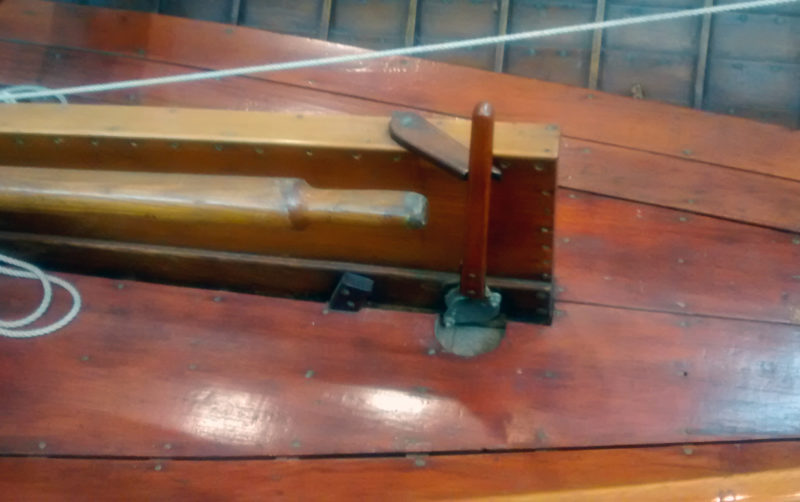 Christopher Cunningham
Christopher CunninghamThe lever that operated the centerboard used friction to hold the board down when it was in use. The pivoting latch was used on PRIM, but my father’s boat had a fixed latch that the lever snapped into.
The centerboard had a mahogany lever on the starboard side of the trunk that Dad let me operate. When the board was down I could sit on the trunk cap because there wasn’t any hardware on top of it and there were no holes to squirt water. A slotted cleat on the transom held the blades of the oars when they were tucked out of the way under the port side deck for sailing. Details like these impress me now that I know something about boats, but back then I didn’t think there was anything special about them. The Amphi-craft was just a boat, and it was it how I thought all boats were supposed to be.
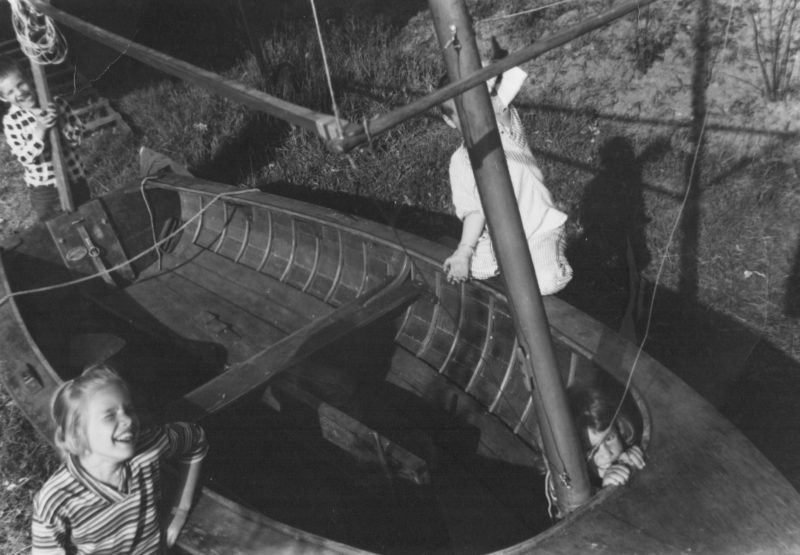 Cunningham family collection
Cunningham family collectionDad’s Amphi-craft, CALYPSO, was a welcome addition to the back yard. I’m at the stern, my older sister Laurie is at left, and my younger sister Ellyn is peeking out over the foredeck as she often did while sailing with Dad. We don’t recall who’s behind the mast.
I remember Mom going out with Dad once, and only once, for a short ride in the Amphi-craft. It must have been the first time Dad launched the boat after restoring it, because all five of us—Mom, Dad, my two sisters, and I—went to the beach, and not all of us could go sailing at the same time. So it’s likely that the boat was christened on that outing. The Amphi-craft was named CALYPSO, the same as the title of a Harry Belafonte record album that came out in 1956, the one with Belafonte in a green shirt against a red background. It was one of the few records my parents owned and must have been a favorite. My two sisters and I would have been waiting on the beach while Dad took Mom out first. They weren’t on the water long. The boat had probably been out of the water for years, and the copper-fastened cedar planks needed some time to soak up enough moisture to close the laps and keep the boat dry. I don’t know how much water had come aboard; it wouldn’t have been alarming to Dad, who had grown up around boats, but it would have been to Mom, who was born and raised in the desert town of Ely, Nevada. I’m sure that she demanded in no uncertain terms to be put ashore. It was the last time I ever saw her aboard one of Dad’s sailboats.
My younger sister, Ellyn, recalls “When I went sailing with Dad in the Amphi-craft, it was always just the two of us. I was 5 or 6 years old and we would set sail just south of the Edmonds ferry dock. Sometimes the water was fairly calm but other times it would get choppy and I’d get scared. I crawled up under the foredeck to stay safe, but Dad told me to peek out over the bow so I could the see the waves as they came so I could ride them out. That made it a lot more fun, like a roller coaster, and I wasn’t afraid any more. Dad would get the sail full and the boat would sometimes lean over so that the water would just start coming over the gunwale, but I was always happy being with Dad and never worried that boat would capsize.”
The times I remember sailing aboard the Amphi-craft, the wind was always up. Dad preferred charging through the chop to lolling about in the lifeless air of a sunny summer day. Spray was always coming over the bow. When I got cold, I’d crawl past the mast, like Ellyn did, and take shelter under the foredeck. That tiny space resonated with the sound of water tearing across the laps.
Dad often sailed alone aboard CALYPSO and would venture well out into Puget Sound. On one outing, he wanted to see how well the boat would sail on a reach with the centerboard retracted. A gust capsized him. Puget Sound is never warm; the water temperature never gets much above 50 degrees. Dad, swimming around CALYPSO, was busy gathering up all the bits of equipment that had gone adrift when a cabin cruiser came alongside. The skipper, Dad told us that evening, leaned out of a cabin window and said in a thick Russian accent, “You know you can only live 15 minutes in that water.” That’s not quite right—you’d only be incapacitated in 15 minutes, but as good as dead without a rescue. Dad was lucky the man had seen him go over. This was the only capsize I recall hearing about, but Ellyn remembers Dad often coming home from solo outings soaking wet.
I don’t know what became of the Amphi-craft. One day it was gone—Dad must have sold it. I never saw it again, but I have to believe it left a mark on me that hasn’t been slowly and inexorably erased by time, as memories of the boat have been. The sound of a lapstrake boat in the waves is as beautiful to me as any music; the fragrance of cedar, oak, and varnish are as alluring as any perfume. And what did I find in my father as he sat in the stern with one hand on the sheet and the other on the tiller, taking a face-full of cold spray with every wave that shattered against CALYPSO’s flanks? I doubt he would have ever passed off the experience of sailing a small boat as mere fun or excitement. I know now that magic would be closer to the truth.![]()

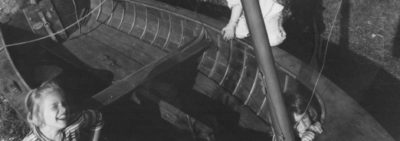
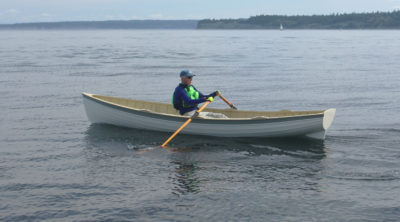

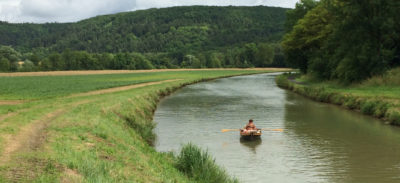

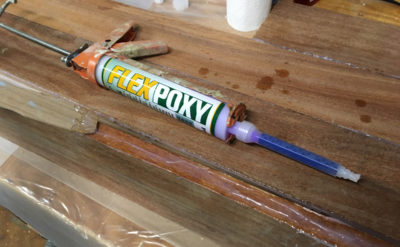
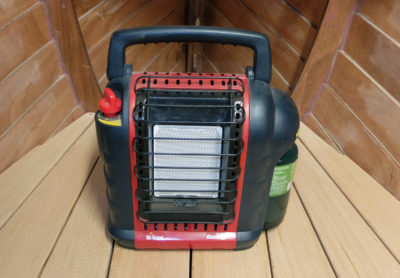
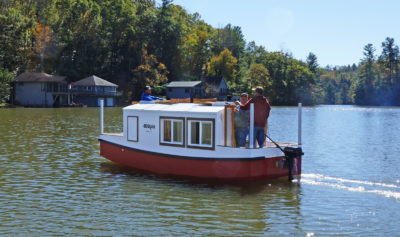
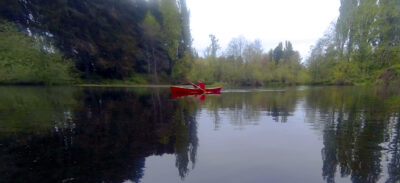
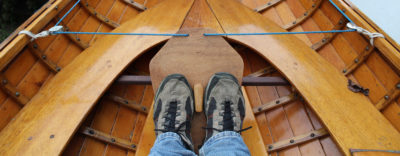
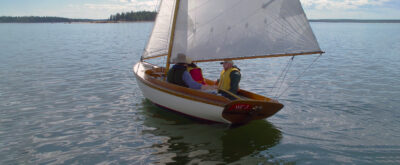
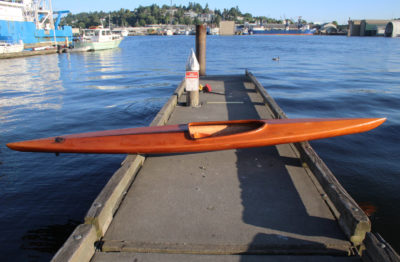
Of all the boats I saw at Mystic, the Amphi-craft was my favorite. I’ve seen PRIM at the Providence airport a lot as well, and think they are fine vessels, lots of care and detail packed into a small package. Thanks for sharing your memories!
As an owner and builder of the Catspaw dinghy for some 10 years now, I share the enthusiasm for this type of boat. I sail her with a traditional boom, not the prescribed lug rig. The boom sits well in the boat when I’m rowing. I will be adding a sliding rowing seat this summer. These boats row exceptionally well.
Perhaps the Amphi-craft was a design ahead of her time? I have looked at photos of the boat over decades, and I still find her difficult to resist. My boating thoughts are conflicted in many ways, but predominantly by the battle between larger vs smaller. As I approach 64 years of age, the battle has been won in my head (if not in my heart) and my personal sailing is done in smaller boats. They are used more frequently, and they have a positive effect on more lives.
As for the sound of waves on timber planking, there is a part of my brain which records those sounds on every sailing outing, and the peace-of-mind they induce permeates my being for months. Thanks for the inspiring article.
Greetings Chris,
This evening I browsed through Small Boats Magazine and came across your March 2018 article entitled “Imprinted.” Your skillful weaving of technical details, photographs, personal recollections of yours and your sisters, as well as your appreciation (from an adult’s perspective) for the joy you know your father experienced while sailing CALYPSO, all came together in an informative and warm, personal reminiscence. I thought it was wonderful. I enjoyed it immensely and wanted to tell you so.
Best Wishes,
Roger Rodibaugh
Melonseed skiff THREE CHEERS